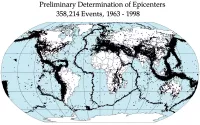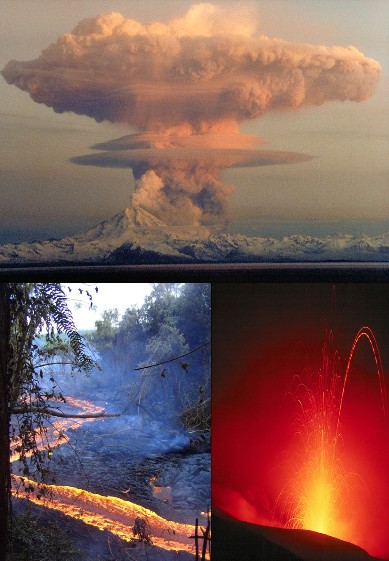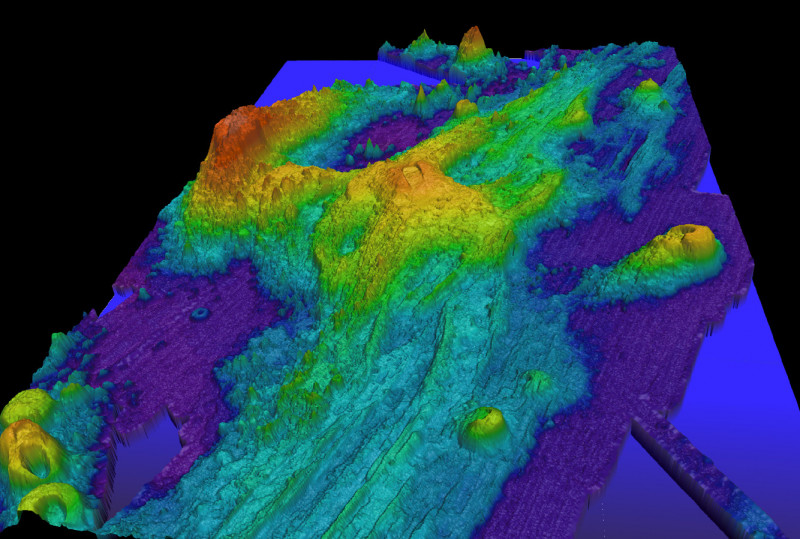Axial Seamount is a submarine volcano situated on the Juan de Fuca Ridge, approximately 480 km west of Oregon. It's the youngest volcano and current eruptive center of the Cobb-Eickelberg Seamount chain, rising 1,100 m from the ocean floor. This geologically complex seamount lies at the intersection of a hotspot and a mid-ocean ridge, resulting in poorly understood origins. It features a rectangular caldera and rift zones extending northeast and southwest. Its flanks are marked by fissures, vents, sheet flows, and pit craters. The seamount's geology is further complicated by its intersection with surrounding smaller seamounts.
2 hours ago : Axial Seamount: Mile-Wide Underwater Volcano off Oregon Coast Could Erupt Soon
Axial Seamount, a mile-wide underwater volcano off the Oregon coast, is showing signs of an impending eruption. Seismic activity suggests it could erupt anytime, posing potential risks to the surrounding marine environment.
1981: First Bathymetry
In 1981, the first bathymetry of Axial Seamount was compiled by the NOAAS Surveyor during SeaBeam trials. The survey aimed to link seafloor hydrothermal activity to geomorphic features and found areas of increased temperature concentration.
1983: Low-Temperature Venting Discovery
In 1983, dives at the northern rift zone of Axial Seamount found extensive low-temperature venting.
1983: Discovery of Black Smoker Vents
In 1983, submersible dives with Pisces IV and DSV Alvin led to the discovery of the first active black smoker vents in the north Pacific.
1983: Canadian American Seamount (CASM) Expedition
In 1983, the Canadian American Seamount (CASM) expedition visited Axial Seamount's summit caldera and discovered a vibrant hydrothermal vent community.
1984: Further Discoveries of Black Smoker Vents
In 1984, submersible dives with Pisces IV and DSV Alvin led to further discoveries of active black smoker vents in the north Pacific.
1987: Deployment of Volcanic Systems Monitors
Beginning in 1987, pressure, tilt, and temperature sensors, along with seismometers, were deployed on Axial Seamount as part of the Volcanic Systems Monitors (VSN) program.
1987: Deployment of Bottom Pressure Recorders
From 1987, bottom pressure recorders deployed on Axial Seamount recorded instances of deflation in the summit surface, indicating lava movement.
1991: Seismic Activity
Between 1991 and 1996 Axial Seamount experienced a single earthquake swarm of over 50 events.
1991: Bathymetric Detailing by NOAAS Discoverer
In 1991, the NOAAS Discoverer conducted further bathymetric surveys of Axial Seamount, detailing the seamount further.
1991: NOAA Access to SOSUS
In 1991, the National Oceanic and Atmospheric Administration (NOAA) gained access to the United States Navy's SOSUS system to monitor seismic activity.
1992: End of Bottom Pressure Recorders Deployment
By 1992, bottom pressure recorders deployed on Axial Seamount recorded five instances of deflation in the summit surface, indicating lava movement.
1992: Continuation of Volcanic Systems Monitors Deployment
Continuing until 1992, more pressure, tilt, and temperature sensors, and seismometers were deployed on Axial Seamount as part of the Volcanic Systems Monitors (VSN) program.
1992: Sensor Deployment
Throughout 1992, a large package of sensors was deployed on Axial Seamount to monitor its activity.
1993: NOAA Real-time Monitoring System
Since 1993, the NOAA has maintained a real-time monitoring system that alerts the organization whenever an event occurs.
1996: Seismic Activity
Between 1991 and 1996 Axial Seamount experienced a single earthquake swarm of over 50 events.
1996: Establishment of NeMO
In 1996, the New Millennium Observatory (NeMO) was established on Axial Seamount to study volcanic perturbations and their effects on hydrothermal communities.
1996: Establishment of the New Millennium Observatory
In 1996, the New Millennium Observatory was established on the flanks of Axial Seamount.
November 1997: Increased Seismic Activity
Between May and November 1997, seismic activity at Axial Seamount increased markedly, with SOSUS recording five earthquake swarms. By 29 November 1997 the swarm had moved south by 50 km.
January 1998: Submarine Eruption
In January 1998, a submarine eruption was detected at Axial Seamount, marking the first time such an event was detected and monitored in situ. This event garnered significant scientific interest.
January 1998: Eruption and Earthquake Swarm
In January 1998, around the time of the eruption, a massive 11-day, 8247-quake event occurred at Axial Seamount.
February 1998: First Post-Eruption Expedition
On 12 February 1998, the RV Wecoma conducted the first post-eruption expedition to Axial Seamount, performing conductivity, temperature, depth, and optical casts.
1998: Decrease in Seismic Activity
After the 1998 eruption, seismic activity at Axial Seamount virtually disappeared.
1998: Eruption Preceded by Earthquake Swarms
In 1998, the eruption of Axial Seamount was preceded by large earthquake swarms.
1998: Size comparison of the 2011 and 1998 eruptions
In April 2011, the volcanic eruption was three times larger than the 1998 eruption.
2000: Annual Measurements with ROVs
Since 2000, annual measurements using pressure sensors mounted on Remotely Operated underwater vehicles (ROVs) have been applied to local benchmarks.
2006: Recalculation of Next Eruption
In 2006, William Chadwick and his associates calculated that the next eruption of Axial Seamount would occur in approximately 2014.
April 2011: Axial Seamount Eruption
In April 2011, Axial Seamount erupted again, producing a lava flow that was 1.6 km wide.
July 2011: Discovery of New Lava Flows
In July 2011, ROV Jason discovered new lava flows on Axial Seamount that had not been present the year before.
2014: Predicted Eruption Date
In 2006, it was predicted that an eruption would occur around 2014.
2015: Axial Seamount Eruption
In 2015, Axial Seamount had another eruption.
2025: Expected Eruption
In 2025, another eruption is expected at Axial Seamount.
Mentioned in this timeline
The United States of America is a federal republic of...

A submarine is a watercraft capable of independent operation underwater...

An earthquake is the shaking of the Earth's surface caused...

Black is an achromatic color representing the absence of light...

A volcanic eruption is the release of material from a...

A community is a social unit defined by a shared...
Trending

57 minutes ago Chet Holmgren's Impact: Key Player Props and the Factor for Beating Denver
57 minutes ago Curtis Yarvin, DOGE Inspiration, Now Scorns It; Debated by Harvard Professor.

57 minutes ago Royals' Outfield Woes and Offseason Misses Highlighted Amidst Team's Recent Success.

58 minutes ago Diamondbacks' New City Connect Uniforms: A Sleek Redesign Featuring Purple and Teal

58 minutes ago Virat Kohli's potential Test retirement shocks BCCI ahead of England tour: Report.

58 minutes ago Michael Porter Jr. battles shoulder injury in Nuggets-Thunder series, future uncertain.
Popular

Jane Goodall is a renowned English primatologist zoologist and anthropologist...

Pope Francis is the current head of the Catholic Church...

Cristiano Ronaldo often nicknamed CR is a highly decorated Portuguese...
The Real ID Act of is a US federal law...

Michael Jordan also known as MJ is an American businessman...

Russell Westbrook III is an American professional basketball player currently...
